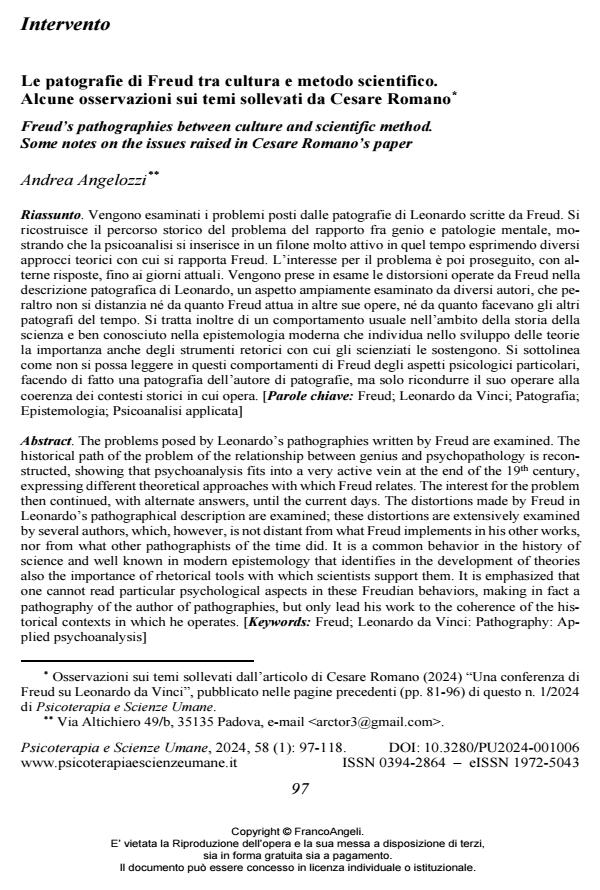Intervento. Le patografie di Freud tra cultura e metodo scientifico. Alcune osservazioni sui temi sollevati da Cesare Romano
Titolo Rivista PSICOTERAPIA E SCIENZE UMANE
Autori/Curatori Andrea Angelozzi
Anno di pubblicazione 2024 Fascicolo 2024/1
Lingua Italiano Numero pagine 22 P. 97-118 Dimensione file 191 KB
DOI 10.3280/PU2024-001006
Il DOI è il codice a barre della proprietà intellettuale: per saperne di più
clicca qui
Qui sotto puoi vedere in anteprima la prima pagina di questo articolo.
Se questo articolo ti interessa, lo puoi acquistare (e scaricare in formato pdf) seguendo le facili indicazioni per acquistare il download credit. Acquista Download Credits per scaricare questo Articolo in formato PDF

FrancoAngeli è membro della Publishers International Linking Association, Inc (PILA)associazione indipendente e non profit per facilitare (attraverso i servizi tecnologici implementati da CrossRef.org) l’accesso degli studiosi ai contenuti digitali nelle pubblicazioni professionali e scientifiche
Vengono esaminati i problemi posti dalle patografie di Leonardo scritte da Freud. Si ricostruisce il percorso storico del problema del rapporto fra genio e patologie mentale, mostrando che la psi-coanalisi si inserisce in un filone molto attivo in quel tempo esprimendo diversi approcci teorici con cui si rapporta Freud. L’interesse per il problema è poi proseguito, con alterne risposte, fino ai giorni attuali. Vengono prese in esame le distorsioni operate da Freud nella descrizione patogra-fica di Leonardo, un aspetto ampiamente esaminato da diversi autori, che peraltro non si distanzia né da quanto Freud attua in altre sue opere, né da quanto facevano gli altri patografi del tempo. Si tratta inoltre di un comportamento usuale nell’ambito della storia della scienza e ben conosciuto nella epistemologia moderna che individua nello sviluppo delle teorie la importanza anche degli strumenti retorici con cui gli scienziati le sostengono. Si sottolinea come non si possa leggere in questi comportamenti di Freud degli aspetti psicologici particolari, facendo di fatto una patografia dell’autore di patografie, ma solo ricondurre il suo operare alla coerenza dei contesti storici in cui opera.
Parole chiave:Freud; Leonardo da Vinci; Patografia; Epistemologia; Psicoanalisi applicata
Andrea Angelozzi, Intervento. Le patografie di Freud tra cultura e metodo scientifico. Alcune osservazioni sui temi sollevati da Cesare Romano in "PSICOTERAPIA E SCIENZE UMANE" 1/2024, pp 97-118, DOI: 10.3280/PU2024-001006